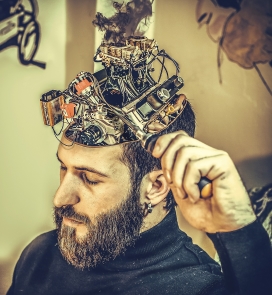
When we hear of augmentation in digital terms, these days we more often than not think of augmented or mixed reality, where digital information, imagery etc. is overlain on our view of the real world around us. This is, as yet, a relatively specialised field in archaeology (e.g. see Eve 2012). But digital augmentation of archaeology goes far beyond this. Our archaeological memory is augmented by digital cameras and data archives; our archaeological recording is augmented by everything from digital measuring devices through to camera drones and laser scanners; our archaeological illustration is augmented by a host of tools including CAD, GIS, and – potentially – neural networks to support drawing (e.g. Ha and Eck 2017); our archaeological authorship is augmented by a battery of writing aids, if not (yet) to the extent that data structure reports and their like are written automatically for us (for example).
As archaeologists have become increasingly digital, so software and hardware devices have combined to augment archaeological practice. As Morgan and Eve (2012, 523) have proposed, archaeologists are increasingly akin to Donna Haraway’s famous cyborgs, “hybrids of machine and organism” (Haraway 1991, 291), as we “… delegate a significant share of our work and life as archaeologists to digital devices” (Morgan and Eve, op cit). Those of us old enough to remember a largely pre-digital archaeology can easily appreciate the extent of this change, but the speed and scope of change means that digital natives will be equally witness to, for instance, the downsizing of digital devices and their insinuation into the archaeological every-day. So augmentation is an unalloyed good, then?
Not necessarily. It has long been an objective of digital technologists to make the digital as invisible as possible, whether through making the device itself as imperceptible as possible through miniaturisation and/or disguise, or through making the means by which we interact with it disappear. For example, Ben Bajarin has recently commented on human technological augmentation and suggested that:
As technology continues to augment more and more of our human capabilities my hope is that the technological tool or process involved will fade so deeply into the background that it nearly disappears. This way we can get the most out our time whether at work, school, play, or vacation, and spend less time fidgeting with technology. Ultimately we will be able to do more with technology but also spend less time with the technology itself and more time doing the things we love.
Sounds attractive! But the downside of such a level of augmentation is that we understand less and less about exactly what the technological tool or process is actually doing on our behalf. The cost of spending less time fidgeting with technology is the adoption of a more subservient relationship with the digital devices and their associated web of dependencies, assumptions, methodologies, and so on. The impact of this could be quite substantial. For instance, Bob O’Donnell recently suggested that we’re on the cusp of radical change through adjusting our digital perspective, from outside-in to inside-out. He points to the way that:
… devices are incorporating data from the real-world around us, and enabling us to see an enhanced version of the outside world from the inside out. In a sense, we’re going from digital data inside to digitally-enhanced reality on the outside.
Such a shift entails a significant increase in the use of machine learning and artificial intelligence to capture, process, and re-package the real world into “more meaningful and contextual information”. We’re becoming increasingly accustomed to this kind of behaviour in relation to our online shopping and social media, but are we equally content for our archaeological data and knowledge to be handled in a similar fashion?
I’ve recently argued for the necessity for a form of cognitive digital archaeology in which the digital artefact is deconstructed layer by layer, from the conception of the digital device, through its implementation in hardware and in algorithmic form as code, its incorporation behind interfaces in software, and ultimately its use in an archaeological context (Huggett 2017). The fact that this is not necessary in order to successfully use such digital devices doesn’t detract from this argument. After all, ultimately none of us fully understand all the devices that we regularly employ in our daily lives and that doesn’t diminish their value to us. Instead, this is one area that distinguishes digital archaeologists (as in “we are all digital archaeologists” (Morgan and Eve 2012, 523)) from Digital Archaeologists. But it’s more than just that Digital Archaeologists do fidget with the technologies while digital archaeologists generally get on with digitally augmented things: Digital Archaeologists have a fundamental responsibility to take ownership of the digital devices used, and unpick their methods and theories in order to properly understand and influence their contribution to the broader discipline.
References
Bajarin 2017 ‘Technology and Human Augmentation’, Tech.pinions (19/06/2017) https://techpinions.com/technology-and-human-augmentation/50364
Eve 2012 ‘Augmenting Phenomenology: Using Augmented Reality to Aid Archaeological Phenomenology in the Landscape’, Journal of Archaeological Method and Theory 19 (4), 582-60. http://dx.doi.org/10.1007/s10816-012-9142-7 (available at http://discovery.ucl.ac.uk/1352447/1/Eve_2012_Augmented_Phenomenology.pdf)
Ha and D. Eck 2017 ‘A Neural Representation of Sketch Drawings’, https://arxiv.org/abs/1704.03477
Haraway 1991 Simians, Cyborgs and Women: The Reinvention of Nature, (Routledge: London).
Huggett 2017 ‘The Apparatus of Digital Archaeology’, Internet Archaeology 44. https://doi.org/10.11141/ia.44.7
Morgan and S. Eve 2012 ‘DIY and digital archaeology: what are you doing to participate?’, World Archaeology, 44 (4), 521-537. http://dx.doi.org/10.1080/00438243.2012.741810 (available at http://bit.ly/2s9HV9J)
O’Donnell 2017 ‘Computing Evolves from Outside In to Inside Out’, Tech.pinions (13/06/2017) https://techpinions.com/computing-evolves-from-outside-in-to-inside-out/50331


